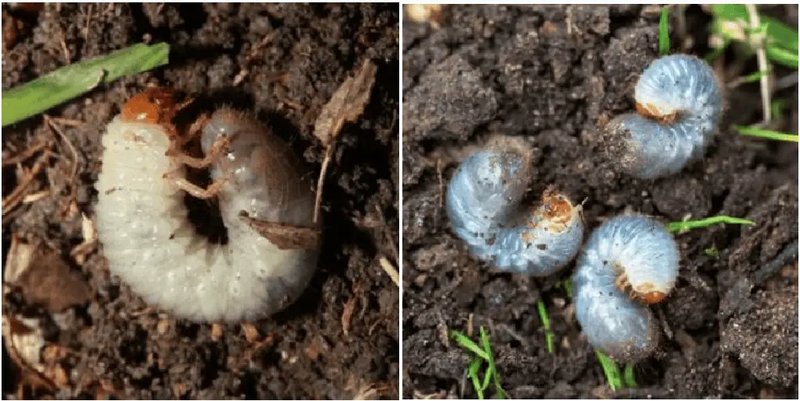
Grub worms, primarily the larvae of beetles, can wreak havoc on your lawn if left unchecked. Knowing how to spot them is crucial for protecting your turf. Just like how a detective picks up clues to solve a mystery, you can learn to recognize the signs of grub worms, allowing you to act before they cause too much damage. Let’s dig into how you can identify these unwelcome guests in your soil and turf.
What Are Grub Worms?
First things first, let’s understand what we’re dealing with. Grub worms are the immature stage of certain beetles, particularly the Japanese beetle, European chafer, and lawn beetle. They usually look like small, white, C-shaped larvae with a brown head. These little guys primarily feed on grass roots, which can lead to dead patches in your lawn.
When you think of grub worms, picture them as little eating machines. They’re most active in late summer and early fall, though they can be present underground for most of the year. Thus, being able to identify them early can save your lawn from serious damage.
The cost of neglecting this problem might surprise you. If grubs are left to their own devices, they can turn a lush lawn into a sad, brown space in no time. Awareness is your first line of defense.
Identifying Signs of Grub Infestation
So, how do you know if you have grub worms in your soil? Keep an eye out for these common signs:
- Browning Patches: If you see irregular patches of brown grass, especially in your lawn’s sunny areas, that’s a major red flag.
- Spongy Ground: When you walk on the grass, does it feel spongy or springy? That’s often an indication of grubs eating the roots.
- Bird Activity: If you notice more birds pecking at your lawn than usual, they might be searching for grubs. Think of them as your little lawn detectives.
If you spot any of these signs, it’s time to investigate further. Don’t wait until the damage is irreversible; understanding these indicators can save you time and money in lawn care.
How to Check for Grub Worms
Ready to uncover the truth? Here’s how to check for grub worms in your soil:
1. Digging Test: Use a spade or trowel to dig up a small section of turf, about a square foot and a few inches deep. Look for any grubs in the soil.
2. Inspecting Roots: Check the roots of the grass you’ve dug up. If they’re chewed or missing, there’s a good chance you have grubs.
3. Count Them: If you find grubs, count how many there are. Generally, more than five grubs per square foot is cause for concern, while ten or more is definitely a problem.
This process might sound intimidating, but it’s pretty straightforward. Getting down to the dirt (literally!) helps you assess the severity of the infestation directly.
Understanding the Life Cycle of Grub Worms
To effectively deal with grub worms, knowing their life cycle is essential. Grubs typically go through several stages:
– Egg Stage: Adult beetles lay eggs in the soil, usually in late spring or early summer.
– Larval Stage: The eggs hatch into grubs and begin munching on your grass roots.
– Pupal Stage: After several weeks, they’ll transform into pupae, getting ready to emerge as adult beetles.
– Adult Stage: Finally, they emerge and start the cycle all over again by laying new eggs.
This cycle is why it’s important to address the problem promptly. If you ignore them during the grub stage, you might find yourself battling against adult beetles next season.
Best Practices for Prevention and Control
Now that you know how to identify grub worms, it’s time to think about prevention and control. Here’s what you can do:
– Healthy Lawn Care: Keep your lawn healthy with proper watering, fertilization, and mowing. A strong lawn can better withstand grub infestations.
– Natural Predators: Introduce natural predators like nematodes, which can help control grub populations without chemicals.
– Pesticides: If the infestation is severe, you might consider using a targeted pesticide. Just be sure to follow the directions and choose a product that’s safe for your lawn type.
Remember, healthy soil leads to healthy grass! Keeping pests at bay often starts with good lawn care habits.
When to Consult a Professional
Sometimes, even after doing your homework, you might find yourself in over your head. If you’re dealing with a significant lawn issue or unsure about your findings, consulting a professional can be a smart move. Lawn care experts can offer tailored advice based on your specific situation.
You might also want a pro’s help if you’re considering chemical treatments, as they can ensure the right products are used safely. Just think of them as your lawn’s superhero!
Getting a handle on how to identify grub worms in your soil and turf is essential for maintaining a healthy, vibrant lawn. By being aware of the signs and understanding these pests’ life cycles, you can act quickly and effectively.
Remember, a little vigilance goes a long way. Protecting your turf isn’t just about stopping grubs; it’s about creating a beautiful outdoor space where you and your family can enjoy time together. Now, go out there and give your lawn the love it deserves!
